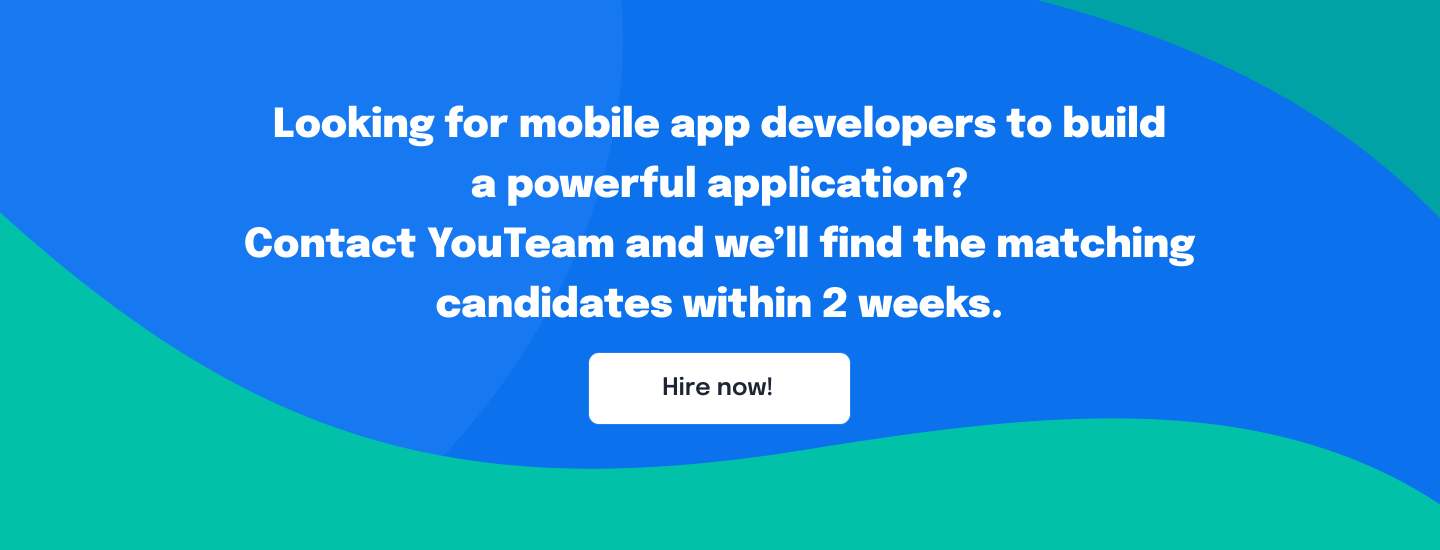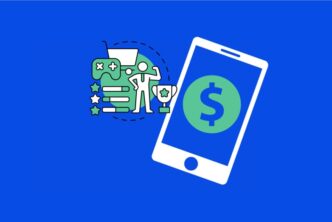In 2022, consumers downloaded over 250 billion apps to their devices. We believe it’s safe to say that there’s no shortage of interest among users for new exciting apps. This doesn’t mean you can just create a mobile app in a couple of weeks and hope for success—launching an application takes effort and an understanding of market trends.
Let’s go over the phases of an app’s life cycle and explore a step-by-step guide to making a successful mobile application, from basic research to an impressive launch.
Table of Contents
How To Make a Successful Mobile App Step by Step
1. Research the Market
Before building your mobile app, you need to dedicate time to pre-development and pre-launch activities. The more effort you put into researching and troubleshooting, the easier it’ll be in the later phases of your journey.
The best place to start is getting to know your environment and how you can make your app the best fit. Even though demand is ever-increasing with the number of users, each niche has numerous competitors fighting for their attention. That’s why it’s essential to know your market, how the competition is positioning, and what pain points you can address.
When looking at the current situation, you should ask questions that help you avoid repeating common mistakes often made while preparing for launch.
For example, “What do users like about the most popular apps in the stores?”, “What’s missing?”, “How do the market leaders position them, and where?” These are some of the questions that you should answer before you proceed.
Thorough research can make a difference between a successful launch that makes noise and just another app that fades out in the first week.
2. Get To Know Your Buyer Persona(s)
Same as for the market, you need to know your future users and get ready to meet your audience’s expectations.
It’s not enough to say you’re creating an app for young people or targeting business teams. To get their attention, you need to understand how you can fit into their daily routine.
Is there a problem you can solve for them or simplify a recurring situation? Do you fill a gap in a particular niche of interest or improve on an existing solution? If you’re working on an app that will resonate with the audience, you should know how and where your product will fit.
This part of the preparation also involves discovering specific communities, not just individual profiles. The better you get to know where your app will land once it launches, the easier it’ll be to promote it.
3. Choose a Pricing Model
You can launch your product as a paid or free app. To monetize free apps, you can use in-app purchases and premium subscriptions.
When deciding on a pricing model for your mobile app, consider whether you want to appeal to a broad audience or a niche market. Calculate the cost of mobile app development and marketing activities, and think about what you’ll need to do to cover those costs and make the app profitable.
Additionally, research other companies in your niche and select your pricing model accordingly. It may be challenging to offer a paid pricing model if your competitors provide free apps.
Browse 500+ Dev Teams Available for Hire
4. Initial Design and Development
After you have validated your idea and product value, start building your product. An average app will take at least three months to create, and there is no need to have a complete product right away. Key aspects of deciding on are the technology stack and the platform you’re using — whether the application will be native, whether you want an iOS or Android app, or whether you’d like to choose cross-platform.
Initially, you should create a roadmap and have a wireframe for your app. Hire a quality team of mobile app developers and start building your application.
5. Start Preparing Your Presence
While your development team is creating your app, you should start spreading the information about your future product and drumming up interest.
An essential step in this direction is setting up a landing page and registering a domain for your app. That will help later during the launch, as it’ll be easier for the audience to find you.
The landing page will serve as a hub for news about the release and a way to get leads and subscribers you can engage with after the launch. Email marketing is another option where you can start sending out emails to potential leads and share details about your new product. Use online generative AI guides to help you with marketing based content ideas that can be used as lead magnets.
The same goes for social media presence — use digital channels as valuable tools for spreading awareness and reaching the buyer persona you created. Create business pages, start advertising campaigns, create effective pop ads, and gather your audience on your profile so that you’ll already have a group of interested people when you are ready to announce the launch. Additionally, if you use Facebook, for instance, make sure to use helpful tools such as a Facebook comment moderation tool to manage comments more productively.
6. Define Clear Goals and KPIs
When you gather information about your buyer persona and the market, it will become more obvious where your app’s strengths are. Based on that, you should decide what you would consider successful. For example, is it important to have as many users as possible, or are you more interested in specific target users? Are you going to include in-app purchases?
With specific metrics in mind, it makes it easier to determine if your launch is a success. However, you can also conduct more productive usability testing and remove all the bumps along the way before your app reaches the end user. Taking into account in-app chat benefits can be helpful, as incorporating this function may strengthen the user experience and boost the app’s overall appeal.
7. Prototype Testing
You should start testing your prototype as soon as possible. It’s a great solution to have an in-house QA engineer check your app through the entire development process. Then, when your prototype is ready, give it to your test audience to get valuable feedback.
Getting your app to a test audience earlier can save time and money. Having test users help work out the bugs will save you the headache of having to go back and fix issues after creating the app.
During the multiple testing phases, you can test out the app to see if it does what it should. For example, you can check to see how much time users need to get to the conversion, if your UX is where you want it to be, and note whether users have issues when navigating and interacting with the app.
Getting relevant test users can also significantly improve the process, so you should always aim for quality over quantity. The closer to the target group you get, the more insights you’ll have to polish everything up as much as possible before the launch.
8. Making Specific Plans
After you’ve gone over all the possibilities, gathered the relevant information, and built and tested your core application, it’s time to set a launch date. The launch date puts pressure on you to fix the bugs and get the app ready for the public and helps build anticipation for your audience. It is also an excellent time to make an overall marketing plan, covering the timeline of your messages, the channels that you’ll use, and the key message you need to communicate.
9. Beta Release
With everything in place, you should create a controlled release as a dry run for a few testers to see how the final product acts in the “real world.” This limited trial will give you the opportunity to work out any last-minute glitches before the app is available to the public.
Same as with the earlier testing, the research should be specific and aim to check if every functionality is in place.
You can use these insights and get even closer to the big launch.
10. Choose Your Launch Platform
Based on the decision that you’ve made regarding technology and development, you should pick stores where your app will be available. Go through the approval process and set the launch process in motion.
Each mobile app store has rules and regulations to follow when publishing your application. Carefully read and familiarize yourself with all the details and prepare your app to meet their requirements.
This involves creating a description and other materials, such as high-quality screenshots and videos, to showcase it. If you follow the guidelines each store provides, your app should be published in just a few days.
11. Launch Time
Even though it’s the most exciting part of the process, with all the thorough preparation you’ve done before, this should be the easiest part as well.
Use the materials you created along the way and make a push through all available channels. Whether you’ve opted for influencers or PR articles, the key is to make the call-to-action for download as attractive and enticing as possible.
Place the store link on your website, send out a newsletter with the page link, and put it in all of your social media bios — this isn’t the time to be modest.
A portion of your budget should go toward paid ads, as they’re the best way to reach your specific target group.
Of course, social media and Google ads are proven ways to get new users, but you should also consider advertising in the stores to make sure your app is as visible as possible.
12. Improve the App’s Visibility in App Stores
Be distinctive when creating a name for your mobile app, and use a subtitle to underline the purpose of your app and the features that will resonate with your audience. Choose keywords based on the words you think your audience will enter in the search box.
Ratings and reviews also affect how your mobile app ranks in search results. Once you’re comfortable with your app’s performance, ask consumers to leave a review and rate it accordingly.
13. Create a Promo Video for Your App
Create a promotional video that showcases your app’s features and post it on social media, the app store page, and the landing page to increase conversions. Additionally, placing a promo video on a website can increase the time spent on the page by 88%. You can even do a live stream to show how all these feautures work, but make sure to use ultra low latency video streaming when doing so.
14. Post-launch Listening
After some time, you’ll have a good idea of how the launch went and if it met your KPIs.
Even though you’ve done most of the work needed, there are still a couple of things you can do to maximize the success of your app. Gathering data through mobile analytics and other types of feedback can prove to be essential for your app’s life cycle.
Monitor all comments on platforms and social media, learn how the app fares among the users, read and respond to users’ comments and suggestions and keep track of your engagement across the channels to stay on top of trends.
You could even consider using an instant messaging API to add chat functionality directly within your app, allowing you to harvest feedback natively and become even more responsive and reactive to the needs of users.
15. React On Feedback
The insight you get from your audience is only valuable if you learn from it and act on it. You should keep testing new performance updates, try fixing bugs that may come up along the way, and even implement new functionalities that your users recommend if they prove to be relevant.
Not only will continuous updates keep your app relevant for longer, but they will also create positive word-of-mouth for your future efforts and nurture the relationship with your community.
Summary
It may seem like a lot to take in, but when you dedicate the time to every part of the process, you’ll see that a good idea can hold up and become a success if you put in enough effort. Start by getting to know your market and get down the specifics of your target group. After that, you should go into initial preparations and lay down the foundations.
Next, you should go into user research and testing the ins and outs of your app. With the valuable insight you’ll gather, you can go on and make more specific plans. Keep track of all the updates you made and the final feedback gathered through beta testing and go forward with final preparations. With your communication plan set in place and all available channels covered, you’ll soon be ready to launch. Just remember — even after your app’s release — you’ll still need to continually work on it. Therefore, keep listening to your users, testing for bugs, updating to stay current, and growing your audience so you’ll be ready for future launches.







